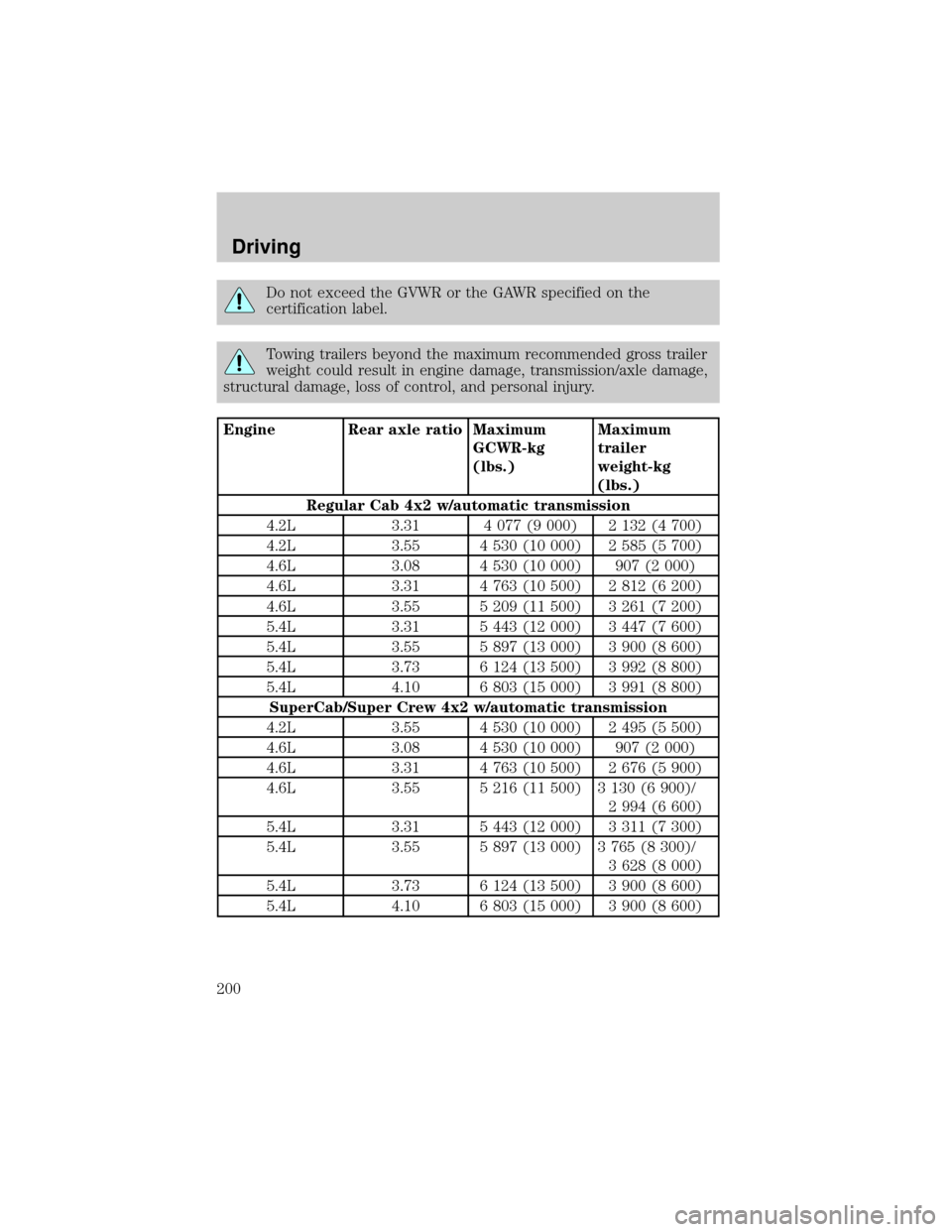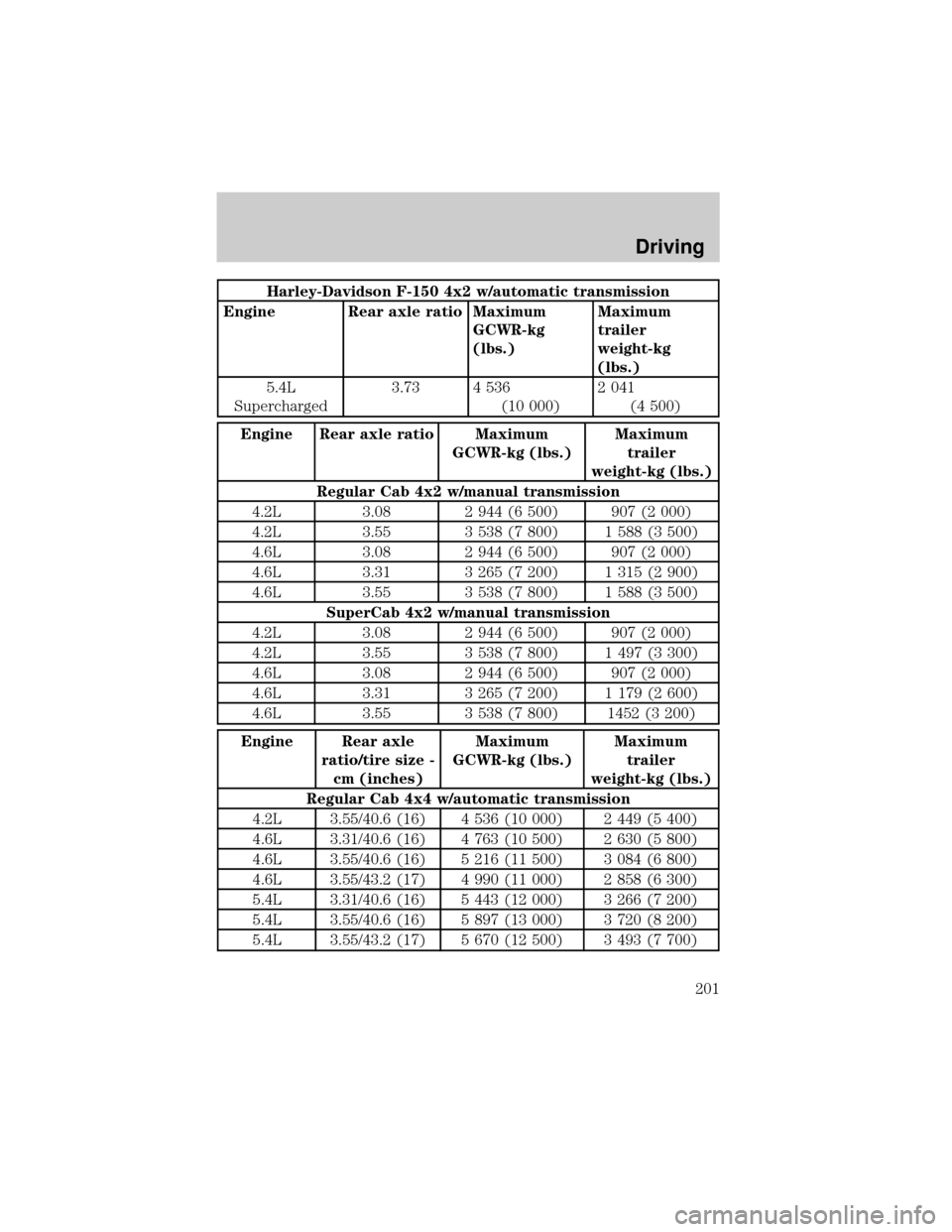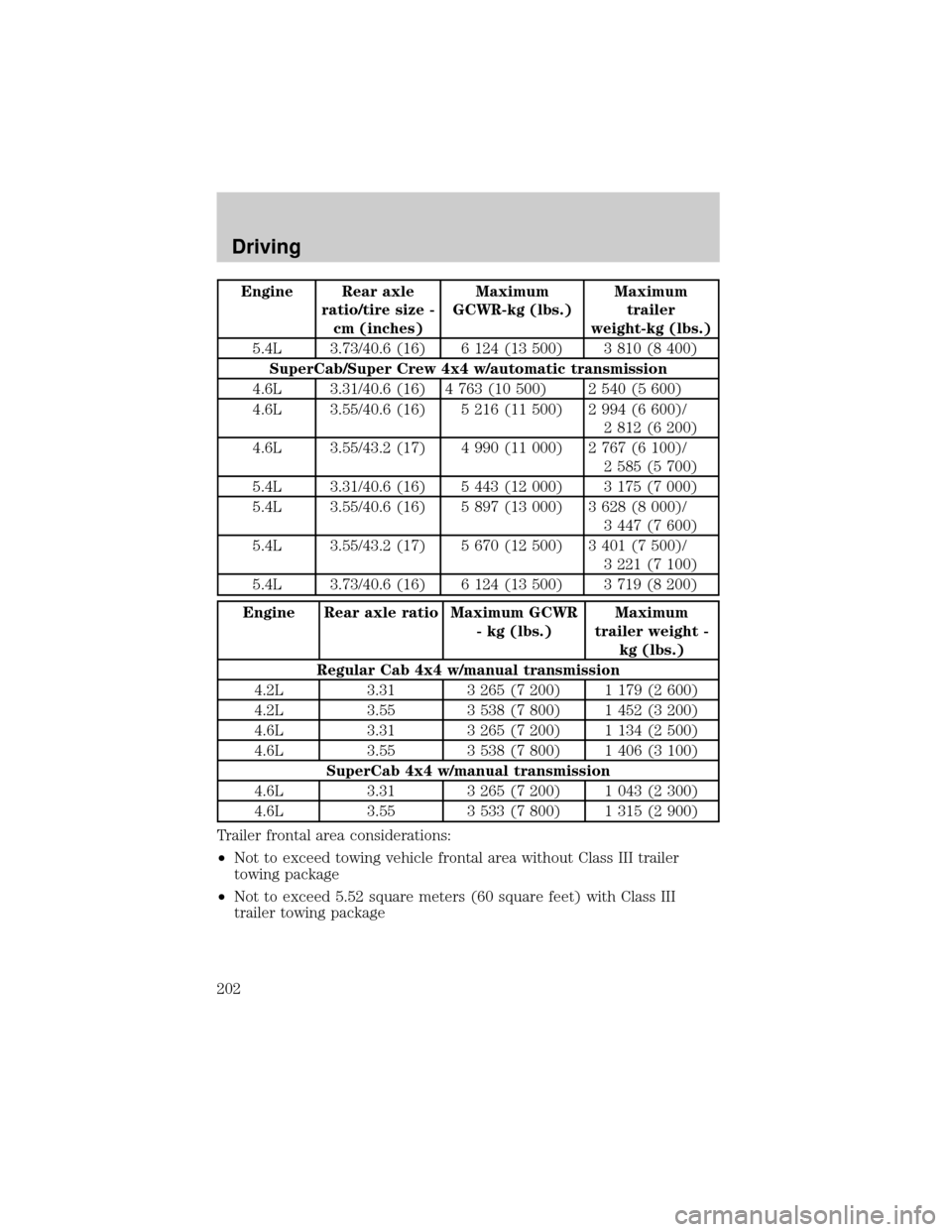2002 FORD F150 transmission
[x] Cancel search: transmissionPage 199 of 320

Special loading instructions for owners of pickup trucks and
utility-type vehicles
For important information regarding safe operation of this type
of vehicle, see thePreparing to drive your vehiclesection in
this chapter.
Loaded vehicles, with a higher center of gravity, may handle
differently than unloaded vehicles. Extra precautions, such as
slower speeds and increased stopping distance, should be taken when
driving a heavily loaded vehicle.
Your vehicle has the capability to haul more cargo and people than most
passenger cars. Depending upon the type and placement of the load,
hauling cargo and people may raise the center of gravity of the vehicle.
Calculating the load your vehicle can carry/tow
1.
Use the appropriate maximum gross combined weight rating (GCWR)
chart to find the maximum GCWR for your type engine and rear axle ratio.
2. Weigh your vehicle as you customarily operate the vehicle without
cargo. To obtain correct weights, try taking your vehicle to a shipping
company or an inspection station for trucks.
3. Subtract your loaded vehicle weight from the maximum GCWR on the
following charts. This is the maximum trailer weight your vehicle can tow
and must fall below the maximum shown under maximum trailer weight
on the chart.
TRAILER TOWING
Your vehicle may tow a class I, II or III trailer provided the maximum
trailer weight is less than or equal to the maximum trailer weight listed
for your engine and rear axle ratio on the following charts.
Your vehicle's load capacity is designated by weight, not by volume, so
you cannot necessarily use all available space when loading a vehicle.
Towing a trailer places an additional load on your vehicle's engine,
transmission, axle, brakes, tires and suspension. Inspect these
components carefully periodically during, and after any towing operation.
Exceeding the maximum GCWR could result in extensive damage
to your vehicle and personal injury.
Driving
199
Page 200 of 320

Do not exceed the GVWR or the GAWR specified on the
certification label.
Towing trailers beyond the maximum recommended gross trailer
weight could result in engine damage, transmission/axle damage,
structural damage, loss of control, and personal injury.
Engine Rear axle ratio Maximum
GCWR-kg
(lbs.)Maximum
trailer
weight-kg
(lbs.)
Regular Cab 4x2 w/automatic transmission
4.2L 3.31 4 077 (9 000) 2 132 (4 700)
4.2L 3.55 4 530 (10 000) 2 585 (5 700)
4.6L 3.08 4 530 (10 000) 907 (2 000)
4.6L 3.31 4 763 (10 500) 2 812 (6 200)
4.6L 3.55 5 209 (11 500) 3 261 (7 200)
5.4L 3.31 5 443 (12 000) 3 447 (7 600)
5.4L 3.55 5 897 (13 000) 3 900 (8 600)
5.4L 3.73 6 124 (13 500) 3 992 (8 800)
5.4L 4.10 6 803 (15 000) 3 991 (8 800)
SuperCab/Super Crew 4x2 w/automatic transmission
4.2L 3.55 4 530 (10 000) 2 495 (5 500)
4.6L 3.08 4 530 (10 000) 907 (2 000)
4.6L 3.31 4 763 (10 500) 2 676 (5 900)
4.6L 3.55 5 216 (11 500) 3 130 (6 900)/
2 994 (6 600)
5.4L 3.31 5 443 (12 000) 3 311 (7 300)
5.4L 3.55 5 897 (13 000) 3 765 (8 300)/
3 628 (8 000)
5.4L 3.73 6 124 (13 500) 3 900 (8 600)
5.4L 4.10 6 803 (15 000) 3 900 (8 600)
Driving
200
Page 201 of 320

Harley-Davidson F-150 4x2 w/automatic transmission
Engine Rear axle ratio Maximum
GCWR-kg
(lbs.)Maximum
trailer
weight-kg
(lbs.)
5.4L
Supercharged3.73 4 536
(10 000)2 041
(4 500)
Engine Rear axle ratio Maximum
GCWR-kg (lbs.)Maximum
trailer
weight-kg (lbs.)
Regular Cab 4x2 w/manual transmission
4.2L 3.08 2 944 (6 500) 907 (2 000)
4.2L 3.55 3 538 (7 800) 1 588 (3 500)
4.6L 3.08 2 944 (6 500) 907 (2 000)
4.6L 3.31 3 265 (7 200) 1 315 (2 900)
4.6L 3.55 3 538 (7 800) 1 588 (3 500)
SuperCab 4x2 w/manual transmission
4.2L 3.08 2 944 (6 500) 907 (2 000)
4.2L 3.55 3 538 (7 800) 1 497 (3 300)
4.6L 3.08 2 944 (6 500) 907 (2 000)
4.6L 3.31 3 265 (7 200) 1 179 (2 600)
4.6L 3.55 3 538 (7 800) 1452 (3 200)
Engine Rear axle
ratio/tire size -
cm (inches)Maximum
GCWR-kg (lbs.)Maximum
trailer
weight-kg (lbs.)
Regular Cab 4x4 w/automatic transmission
4.2L 3.55/40.6 (16) 4 536 (10 000) 2 449 (5 400)
4.6L 3.31/40.6 (16) 4 763 (10 500) 2 630 (5 800)
4.6L 3.55/40.6 (16) 5 216 (11 500) 3 084 (6 800)
4.6L 3.55/43.2 (17) 4 990 (11 000) 2 858 (6 300)
5.4L 3.31/40.6 (16) 5 443 (12 000) 3 266 (7 200)
5.4L 3.55/40.6 (16) 5 897 (13 000) 3 720 (8 200)
5.4L 3.55/43.2 (17) 5 670 (12 500) 3 493 (7 700)
Driving
201
Page 202 of 320

Engine Rear axle
ratio/tire size -
cm (inches)Maximum
GCWR-kg (lbs.)Maximum
trailer
weight-kg (lbs.)
5.4L 3.73/40.6 (16) 6 124 (13 500) 3 810 (8 400)
SuperCab/Super Crew 4x4 w/automatic transmission
4.6L 3.31/40.6 (16) 4 763 (10 500) 2 540 (5 600)
4.6L 3.55/40.6 (16) 5 216 (11 500) 2 994 (6 600)/
2 812 (6 200)
4.6L 3.55/43.2 (17) 4 990 (11 000) 2 767 (6 100)/
2 585 (5 700)
5.4L 3.31/40.6 (16) 5 443 (12 000) 3 175 (7 000)
5.4L 3.55/40.6 (16) 5 897 (13 000) 3 628 (8 000)/
3 447 (7 600)
5.4L 3.55/43.2 (17) 5 670 (12 500) 3 401 (7 500)/
3 221 (7 100)
5.4L 3.73/40.6 (16) 6 124 (13 500) 3 719 (8 200)
Engine Rear axle ratio Maximum GCWR
- kg (lbs.)Maximum
trailer weight -
kg (lbs.)
Regular Cab 4x4 w/manual transmission
4.2L 3.31 3 265 (7 200) 1 179 (2 600)
4.2L 3.55 3 538 (7 800) 1 452 (3 200)
4.6L 3.31 3 265 (7 200) 1 134 (2 500)
4.6L 3.55 3 538 (7 800) 1 406 (3 100)
SuperCab 4x4 w/manual transmission
4.6L 3.31 3 265 (7 200) 1 043 (2 300)
4.6L 3.55 3 533 (7 800) 1 315 (2 900)
Trailer frontal area considerations:
²Not to exceed towing vehicle frontal area without Class III trailer
towing package
²Not to exceed 5.52 square meters (60 square feet) with Class III
trailer towing package
Driving
202
Page 204 of 320

Trailer brakes
Electric brakes and manual, automatic or surge-type trailer brakes are
safe if installed properly and adjusted to the manufacturer's
specifications. The trailer brakes must meet local and Federal
regulations.
Do not connect a trailer's hydraulic brake system directly to your
vehicle's brake system. Your vehicle may not have enough
braking power and your chances of having a collision greatly increase.
The braking system of the tow vehicle is rated for operation at the
GVWR not GCWR.
Trailer lamps
Trailer lamps are required on most towed vehicles. Make sure your
trailer lamps conform to local and Federal regulations. See your dealer or
trailer rental agency for proper instructions and equipment for hooking
up trailer lamps.
Using a step bumper (if equipped)
The rear bumper is equipped with an integral hitch and only requires a
ball with a 25.4 mm (one inch) shank diameter. The bumper has a 2 270 kg
(5 000 lb.) trailer weight and 227 kg (500 lb.) tongue weight capacity.
If it is necessary to relocate the trailer hitch ball position, a
frame-mounted trailer hitch must be installed.
Driving while you tow
When towing a trailer:
²Ensure that you turn off your speed control. The speed control may
shut off automatically when you are towing on long, steep grades.
²Consult your local motor vehicle speed regulations for towing a trailer.
²Use a lower gear when towing up or down steep hills. This will
eliminate excessive downshifting and upshifting for optimum fuel
economy and transmission cooling.
²Anticipate stops and brake gradually.
Exceeding the GCWR rating may cause internal transmission
damage and void your warranty coverage.
Driving
204
Page 205 of 320

Servicing after towing
If you tow a trailer for long distances, your vehicle will require more
frequent service intervals. Refer to your scheduled maintenance guide for
more information.
Trailer towing tips
²Practice turning, stopping and backing up before starting on a trip to
get the feel of the vehicle trailer combination. When turning, make
wider turns so the trailer wheels will clear curbs and other obstacles.
²Allow more distance for stopping with a trailer attached.
²The trailer tongue weight should be no more than 10±15% of the
loaded trailer weight.
²After you have traveled 80 km (50 miles), thoroughly check your
hitch, electrical connections and trailer wheel lug nuts.
²When stopped in traffic for long periods of time in hot weather, place
the gearshift in P (Park) (automatic transmissions) or N (Neutral)
(manual transmissions). This aids engine cooling and air conditioner
efficiency.
²Vehicles with trailers should not be parked on a grade. If you must
park on a grade, place wheel chocks under the trailer's wheels.
Launching or retrieving a boat
When backing down a ramp during boat launching or retrieval:
²do not allow the static water level to rise above the bottom edge of
the rear bumper.
²do not allow waves to break higher than 15 cm (6 inches) above the
bottom edge of the rear bumper.
Exceeding these limits may allow water to enter critical vehicle
components, adversely affecting driveability, emissions, reliability and
causing internal transmission damage.
Replace the rear axle lubricant any time the axle has been submerged in
water. Rear axle lubricant quantities are not to be checked or changed
unless a leak is suspected or repair required.
Disconnect the wiring to the trailer before backing the trailer into the
water. Reconnect the wiring to the trailer after the trailer is removed
from the water.
Driving
205
Page 206 of 320

RECREATIONAL TOWING (ALL WHEELS ON THE GROUND)
An example of recreational towing would be towing your vehicle behind a
motorhome. Follow these guidelines if you have the need for recreational
towing your vehicle with all four wheels on the ground. These guidelines are
designed to ensure that your transmission is not damaged.
2WD vehicles (with automatic transmissions)
²Place the transmission in N (Neutral)
²Maximum speed is 56 km (35 mph)
²Maximum distance is 80 km (50 miles)
If a distance of 80 km (50 miles) or a speed of 56 km (35 mph) must be
exceeded, the drive shaft will have to be removed before the vehicle is towed.
Ford recommends the driveshaft be removed/installed only by a qualified
technician. See your local dealer for driveshaft removal/installation.
Improper removal/installation of the driveshaft can cause
transmission fluid loss, damage to the driveshaft and internal
transmission components.
4WD vehicles electronic shift transfer case (with automatic
transmissions)
4x4 vehicles with electronic shift on the fly cannot be towed with any
wheels on the ground.
SNOWPLOWING
Ford recommends the following specifications for low speed, personal
use snow removal:
²
F-150 4x4 (except F-150 Supercrew, ªLightningº and ªHarley-Davidsonº)
²5.4L engine
²Heavy duty service package
²Super engine cooling
²Heavy duty front suspension package
²Automatic transmission with auxiliary automatic transmission fluid
cooling
²All-terrain tires
²Limited slip and optional axle ratio.
Do not install a snowplow and plow with your vehicle until it has been
driven at least 800 km (500 miles).
Driving
206
Page 207 of 320

Installing the snowplow
Removing the blocker beam without installing snowplow
attachment hardware may affect air bag deployment in a crash.
Do not operate the truck unless either the blocker beam or snowplow
attachment hardware is installed on the vehicle.
Read the following instructions before installing a snowplow:
²Front GAWR must not exceed 63% of the GVW. Add ballast weight to
the back of the vehicle, if necessary. Refer to the Safety Compliance
Certification Label to find Front GAWR.
²The Front Axle Accessory Reserve Capacity and the Total Accessory
Reserve Capacity listed on the bottom right of the Safety Compliance
Certification Label will determine whether or not the addition of a
snowplow will overload your vehicle.
²The weight of the snowplow and supporting components distributed to
the front axle must not exceed the front accessory reserve capacity.
²The total weight of the snowplow and aftermarket equipment must
not exceed the Total Accessory Reserve Capacity.
²The weight of the installed snowplow and aftermarket equipment must
not load the vehicle beyond the GAWR (front/rear) and GVWR listed
on the Safety Compliance Certification Label.
²The total weight of the snowplow and aftermarket equipment must be
considered part of the payload and must not exceed the Gross
Combined Weight Rating (GCWR) for towing.
²Federal and most local regulations require additional exterior lamps
for snowplow-equipped vehicles. Consult your dealer for additional
information.
²After installing a snowplow to the vehicle, ensure the vehicle's front
toe alignment and front ride height are within specification (reset if
required). These specifications are located in the vehicle's Workshop
Manual. Adherence to the toe, tire pressures and ride height
specification is important for proper tire wear, ride, handling and
headlight aim. Also, maintain the engine oil and transmission fluid
change intervals following the severe duty schedule.
Do not exceed the GVWR or the GAWR specified on the
certification label.
Driving
207